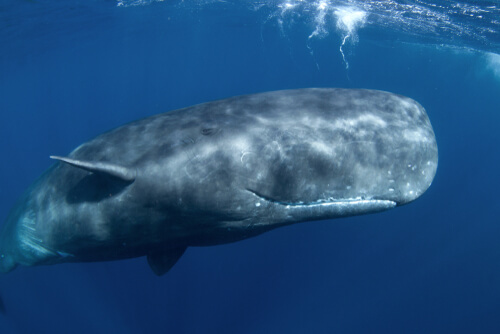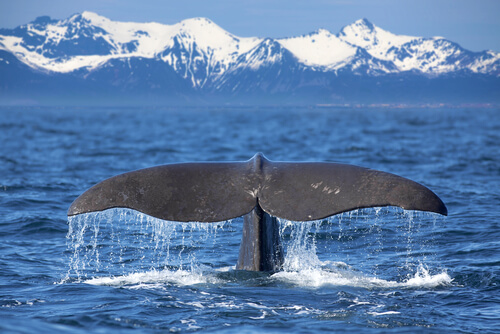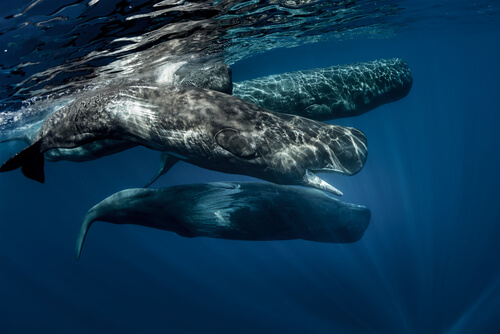
The sperm whale (Physeter macrocephalus), also known as cachalot, is a large predatory whale present in most of the world’s oceans. As the inspiration for the famous novel Moby Dick, the whale’s large and uniquely block-shaped head will be familiar to most. The only member of its genus, the sperm whale has a unique shape, with a large head and a prominent rounded forehead. It is the largest of the toothed whales – a Parvorder of cetaceans that includes dolphins and killer whales – and can reach up to 52 ft (16 m) in length and weighing up to 45 tons (57 000 kg). Its alternative name, cachalot, is derived from an old French word for “big tooth” or “big head”. It is one of the most sexually dimorphic of all cetaceans, with males being 30-50% larger than females. There are two other species – the dwarf sperm whale and pygmy sperm whale – both of the genus Kogia, which are similar to the sperm whale in shape. Together with Physeter, these form the sperm whale family known as Physeteroidae. Sperm whales live in large pods of up to 50 individuals and occur throughout most of the world’s oceans. Adult males populate higher latitudes, but most sperm whales inhabit temperate or tropical oceans and seas. Sperm whales can be found in the Meditteranean. However, none live in the Black Sea while their presence in the Red Sea remains unclear. Sperm whales spend most of their time in deep, offshore waters. This allows them to find their prey which only lives at great depths not found in coastal waters. The sperm whale is predatory. It dives incredibly deep – up to 3 280 ft (1 000 m) – in search of prey such as giant squid and colossal squid. During these hunts, sperm whales often go close to 90 minutes without air. They will also prey on fish and other smaller, medium-sized cephalopod species. Due to their size, they require a large amount of food to sustain themselves. In fact, adult sperm whales will eat about 1 ton (907 kg) of squid and fish per day. In some instances, sperm whales have also been observed attacking large deepwater shark species such as the megamouth shark. While hunting in the darkness of the deep sea, sperm whales use echolocation to locate their prey, a sense also present in dolphins, bats, and other mammals. Sperm whales are a large species and thus have few predators besides humans. Young whales are also quite large, although are susceptible to attacks by Orcas which may relentlessly tire out a migrating mother and calf, eventually overtaking the exhausted young whale as a group. Females give birth once every 4-20 years to a single calf. However, with a lifespan of up to 70 years, they are still able to produce several young during their lifetime. Despite the discrepancy in size between male and female adult sperm whales, all young are born at around 12-14 ft (3.7-4.3 m) in length and weigh about 1 ton (2 200 kg). Young whales grow quickly and females reach sexual maturity at about 36 ft (11 m) in length while males are closer to 50 ft (15 m) when they reach sexual maturity. Sperm whales are a classic example of a K-selected species – a species with a low birth rate, a slow rate of maturation, and a high level of parental care required. These types of species are highly sensitive to environmental conditions and despite their longevity, require forward-looking conservation strategies due to their reproductive habits. Despite this, sperm whales have been a target of whaling fleets for centuries. Various parts of the whale’s body have been used in various human products and many still are highly valued. For example, ambergris, a waxy product found in the digestive system of sperm whales, is highly valued by cosmetic manufacturers for use in perfume and other common products. Interestingly, the wide range in sperm whale birth rate can be largely attributed to the rise and fall of the whaling industry, with females producing more calves when whaling was more common and socially accepted. When fewer whales are killed by humans, environmental limitations likely slow down birth rates, with females not becoming pregnant as frequently as when more whales were being hunted. Sperm whales are listed as “Vulnerable” on the IUCN Red List of Threatened species, while the Meditteranean population is listed as “Endangered”. In some locations, such as the southern coast of Australia, sperm whales are considered to be locally extinct. The species is now protected by the International Whaling Commission. As the inspiration for one of the most famous novels of all time, Moby Dick, sperm whales have been capturing the imagination of humans for centuries. With their ability to dive to extraordinary depths and with heads full of a mysterious substance called spermaceti, it is the non-fiction surrounding the species that is perhaps most interesting. Sperm whales, with their large heads, have the largest brains of any animal to have ever lived. In addition to this massive brain, the whales’ head is full of a substance known as spermaceti. Its function is still not understood. However, it is believed that it may help the deep-diver to regulate its buoyancy. The oily liquid hardens to a wax-like consistency when cold, as it is at the great depths to which the sperm whale dives. Whalers used to believe that the substance was sperm, hence its name and the common name of the species. The sperm whale, like other whales, has a complex social structure and often live in pods of up to 50 individuals. Females will form matriarchal pods consisting of other females and their young, while males will form ‘bachelor herds’ – large groups of males. During the breeding season, of course, these groups will spend much more time together than during other times of the year. Like other whales, sperm whales have complex social structures and the ability to communicate with one another. The movement of nutrients in the ocean is vital to some of the life cycles and adaptations that organisms have evolved. The sperm whale and other deep-diving species provide a unique and fascinating example of this. As described, they eat a large amount of food each day, most of which come from the depths of the oceans. However, their waste is generally deposited closer to the surface. In this way, sperm whales have been said to be responsible for the movement of large amounts of nutrients to the surface waters of the world’s oceans. Without this ‘whale pump’, as it has been dubbed, these nutrients would otherwise be locked up and would decrease the overall productivity of the world’s oceans.
Kingdom
Animalia
Phylum
Chordata
Class
Mammalia
Order
Cetacea
Family
Physeteridae
Genus
Physeter
Species
P. macrocephalus
Niche
Predatory whale
Length
52 ft (16 m)
Weight
60 tons (57 000 kg)
Lifespan
60-70 years
Social Structure
Pods up to 50
Conservation Status
Vulnerable
Average number of offspring
1
Main food item
Squid, fish
Main predators
Humans, Orca
The Basics
Description

Distribution
Diet and Predators
Reproduction

Conservation Status
Fun Facts about the Sperm Whale!
A Head Full

Boy’s Club
The Whale Pump
